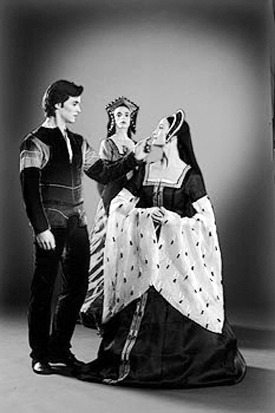Christopher Wheeldon’s ballet looks behind masks in Henry VIII’s court
In Christopher Wheeldon’s ballet “VIII,” there are no happy endings. Instead of taking an abstract idea and using dance to piece it together, this unusual ballet expands on historical reality. Like a Sondheim song, its finest quality lay not in the intricate structures, but in how the dancing revealed character insights.
In many ways “VIII” seemed almost more suitable for the Broadway stage than a classical ballet company, but nobody seemed to care when they stood for curtain calls. Most of the applause was for the two female leads, Kristi Boone as Katherine of Aragon and Sarah Lane as Anne Boleyn, both women who were loved and then rejected by Henry VIII, King of England, played by Gennadi Saveliev. Both women are vivid actresses as well as dancers who flawlessly show their character’s emotions while dancing away their lives.
Katherine’s character was revealed through two types of movement, the first a slow walk onstage where, unseen in the back, she observed the goings on around court. In particular, she watched the dance of Anne Boleyn with her husband, the king—a dance which the rest of the court watched through masks, in the company of several jesters.
Katherine was set apart here because she did not and could not believe in the farce of the court anymore, nor could she live under a mask. Instead, she tears at a banner showing a bright blue sky and pulls it to the ground. Her frustrations are demonstrated even more clearly when she dances with the men, both her jailers and the king. In both cases, she is so weak that she limply hangs there like a doll while the men make her spin and move about.
Anne smugly believes that she is more in control than Katherine. And she is at first. In a seductive pas de deux, Anne leads the king. But eventually her power dims and her emotions change from confidence to anger to fear to misery, all illuminated sharply on the dancer’s face.
Interestingly though, when King Henry, the man who caused such misery for both women, is alone, he reveals through a big leaping dance that he is lonely, insecure and frustrated. Henry almost becomes a foil for these strong women—but not quite. While he holds the power to love or kill, he is haunted by ghosts. His future wives, his court, his son to be, all surround him at various moments in the ballet, blending into the dark, looming set, his palace with an oversized Tudor rose at in the background. As Henry dances and the lighting shifts from yellows and dark blues to blood red, it seems as if the dance is set in the king’s dark mind, where he spins on in a maze of endless passion, forever troubled by the past he created and the future he fears.



































